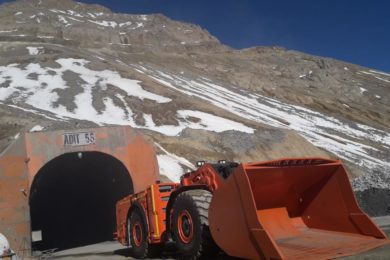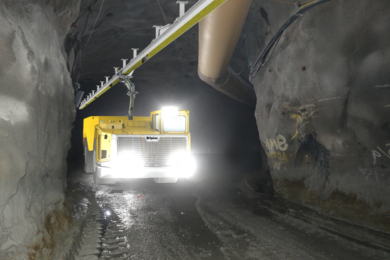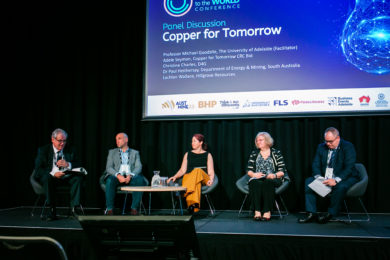IM Editorial Director Paul Moore recently talked to Nicolás Puelma, Disruptive Innovation Director, Codelco and Rodrigo Quiroz, Mine Operations Superintendent, Codelco El Teniente Division about the Chilean copper mining giant’s current and future plans for electrification & autonomy across its underground operations
Q Now that the industry is rapidly moving towards the use of all electric battery equipment, are you now considering that as the next step?
NP: We are looking forward to including fully battery electric equipment in our mining fleets in the near future and consider our hybrid equipment as a transition in terms of fuel efficiency and reduction of local emissions. Battery electric LHDs currently are under development that will meet our operational requirements, not only in terms of equipment availability but in production capacity from OEMs, including LHD models up to 18 t or 20 t and trucks of 40 t capacity and up. We believe OEMs will have these production lines available in the short term – for now they have been announced as being available, but still lack the benefit of extended validation in the field. The hybrid trial tests with a Komatsu 18 t 18HD LHD that we began in 2019 have proven successful and we have managed to meet some of our goals of increasing productivity by more than 10% and cutting diesel consumption by 15-20%. This has allowed us to validate the positive business case of going down the electric route and to understand what is necessary in terms of operational adaptations for an eventual transition to electric mining in the coming years. But the hybrid machine trials continue so we can learn more and as stated with more market development we will be able to scale up this kind of technology. We are also open to engaging with different OEMs collaboratively. The latest news is that we will start a trial of a battery electric LHD (14 t Epiroc ST14 Battery) at El Teniente by the end of these year. We are also looking at battery electric truck options for use underground in El Teniente but no trials have been scheduled so far.

Q Can you give some overview of Codelco’s strategy going forward when it comes to the use of battery equipment in terms of your overall plans for the medium term eg next two to five years?
NP: We foresee interesting opportunities and value by utilising fully electric equipment in our underground operations both current and planned. The adoption of this technology will help us create a better and safer work environment but will also be economically attractive and we hope will also increase our productivity levels in our underground mines. During the coming years, an important volume of production and support equipment will be required for our main underground operations as older fleets are replaced. Therefore, it is a great time for us to make these moves as we are open and willing to test and validate new equipment to identify the best business scenarios prior the scale up of these technologies at our operations. And it is not only about LHDs and trucks, we have also trialled a Liftmaster 600 EB utility vehicle from RDH Scharf and are also looking at options for battery explosive charging, scaling and other machines like personnel carriers.
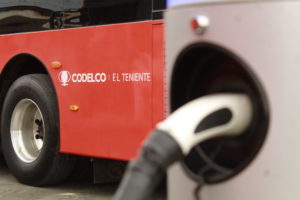
Have aspects such as charging infrastructure been of concern in this consideration of how to move forward?
NP: Charging infrastructure is an interesting aspect of consideration for us, for example with the new 14 t battery electric LHD we will utilise a battery swap system. But we are considering all the different charging technologies in the wide range of new projects we are developing. We have already started evaluating what we need to alter in the design of our future underground projects in order to capture the full potential of electric equipment, such as making reductions in ventilation requirements or even designing our mines in a different way to allow for different heading sizes and underground battery charging stations. The full business case for battery electric requires us to capture the full potential in the infrastructure reduction, given the less DPM that will be generated. This is especially the case given the higher initial cost of these machines.
Q Is the use of battery equipment a major part of the fleet plans at Chuqui Underground?
NP: Definitely, it is a key technology to test and validate, especially considering the next stages of the project which represent even more attractive conditions for electric equipment adoption. This is because of the long lead time in development the current level has already been designed and built for standard diesel equipment, so no special electric charging ports are available and ventilation was built assuming the use of diesel equipment, but in the next level we can design it around fully electric equipment. As stated, once you have the infrastructure already built for diesel then the electric business case is more limited. The battery electric equipment could bring many potential benefits to Chuquicamata that we would like to capture in the near term. So far, the OEM industry has only started deploying the first generations of battery equipped solutions which are mainly for lower sizes equipment, but recently is moving into the sizes we need with machines like Epiroc’s ST18 Battery and Sandvik’s Artisan A18 LHDs. Larger battery trucks are also available now.
Q Do you have any active R&D into the use of hydrogen technology in your mining fleets underground?
NP: The usage of hydrogen technologies in underground mines is not as likely to happen in the short term, especially considering that battery-equipped solutions are already getting close to the sizes we require. Development in the market for hydrogen is happening in Chile, however, and probably could bring interesting opportunities for open pit mining first, given the size of the CAPEX and geographically determined hydrogen generation advantages.
Q What have you learned from your extensive experience with automation underground so far? Does interoperability remain an issue with your autonomous fleets?
RQ: El Teniente has deployed different OEM autonomous solutions of different types over the years as the problems being addressed were different such as differing mine layouts, distances, and availability of crushers. We have seen different effects on proximity sensors depending on dust levels. Variations in conditions underground can produce different automation system perform results, so adjustments and modifications are required. Today, both El Teniente and Chuquicamata Underground are mainly using semiautonomous LHD operation where the mucking is done by remote control then the machine trams and dumps into an ore pass or truck autonomously, so automation as an innovation is here to stay.
Strategically we always prefer to keep our opportunities open in terms of vendors – for example we are already using autonomous solutions from Sandvik and Caterpillar at El Teniente and Chuquicamata, with a new Epiroc fleet also coming to Chuquicamata so interoperability is a real challenge for us as we go forward though work is being done on making systems more open through groups like the GMG. On the systems themselves, there is still a room of improvement in automation in terms of proximity sensors/algorithms to keep boosting the productivity potential further.
Q Have you been able to retrofit automation solutions onto any existing/older machines?
RQ: We have worked extensively with RCT and Hardline at El Teniente on retrofit solutions for both LHDs and rock breakers, but these were teleremote solutions, not what we would call semiautonomous. However, these continue to work well, and we have learned a lot from them. A good example is the RCT ControlMaster Automation solution being used on LHDs loading copper-rich mud in more hazardous areas of the mine.
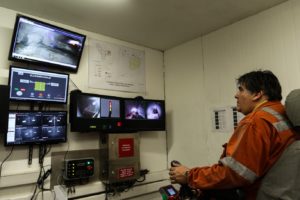
Q Do you have any data that shows in efficiency terms how much more productive autonomous operation has been at El Teniente?
RQ: Considering the variety in operations and equipment we use we must use different performance indicators. Overall, the productivity boost from automation will depend on many factors, but the most relevant is the ability to work continuously without dead times in between shifts. A manual shift means around 30 minutes with the LHD inactive, so depending on whether you have two or three shifts per day you will have 1 to 1.5 hours of extra utilisation, assuming equivalent performance during operation
Q How has automation use evolved within Codelco and where do we go from here?
RQ: Sandvik’s AutoMine was first, going back to 2004 with several versions being used since then. The most recent validation was the Caterpillar Command for underground automation system in El Teniente during 2016-2018. Each operation needs to define what are the specific functionalities required from the autonomous machines to capture the expected KPIs. We call these the ALPHA functionalities, which can be met by different vendors, but one key lesson for us was to look at the specific complexities of our operations and better define those functionalities so we can say more clearly what we expect from these systems in different scenarios.

Going forward we are not just talking about load and haul – drilling is obviously a key activity and also one of the riskiest, especially production drilling, so automation could bring us a safer environment for those operators, which is a core value in Codelco, so we are working on drill automation as well. And network wise, so far we have been using WiFi only but the potential of LTE underground in the future is interesting for us
Q You also opted to use some Chinese Fambition LHDs at El Teniente. What was the rationale behind this?
NP: Fambition LHDs are part of Codelco’s approach to look for new opportunities where we can. This project looks to develop a potential new and feasible alternative from the Chinese market that challenges the status quo from current OEMs, especially relating to cost. The trial of these LHDs is being executed in our El Teniente and Salvador divisions. We are looking to have new and more cost-efficient alternatives according our requirements.
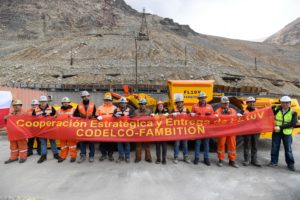
Q: What about more continuous mining methods using for example hard rock cutting technology? Is this an area you plan to explore or are already doing so? Can you give any details of any active projects?
NP: We can’t give any details as these projects are at an early stage, but there are many hundreds of kilometers to develop in Chuquicamata and El Teniente for the years to come so yes hard rock cutting and continuous cutting technologies are very interesting for us and we are working on it.








